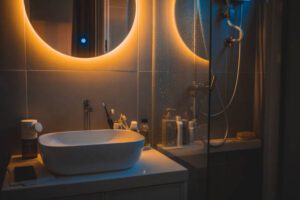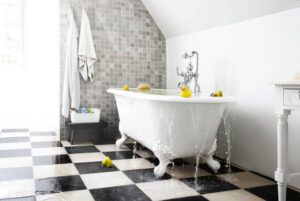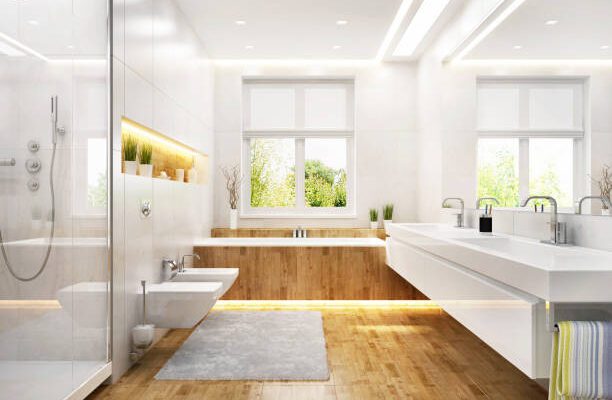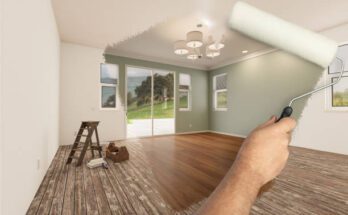As you create your ideal place, keep in mind these bathroom design suggestions and ideas. Find the layouts that work best, spa-like elements to add, and bathroom colour schemes that will make you feel relaxed after a hard day.
Your bathroom ought to be a welcoming area that is both practical and simple to use. It takes attention to detail and a practical mindset to design a bathroom that meets your needs. Decide on the bathroom’s layout before anything else.
Select the bathroom’s plumbing elements, such as the toilet, sink, and shower or tub, as well as the décor, such as baskets for storage, shelving, and a mirror. Then, design the bathroom according to your demands so that it may be built.
Following are a few tips of how you can choose your right bathroom design:
-
Plan Your Bathroom Layout
 (Photo from iStock)
(Photo from iStock)
You have more options with a bathroom plan with two walls. On one wall, the tub and shower can be plumbed, and on the other, the sink and toilet. The most adaptable plan is a three-wall configuration, but it is also the most time- and money-consuming.
Making the most use of space and avoiding costly errors are both benefits of working with a licensed bathroom designer or architect. The area around the tub or right outside the shower is known as the “wet zone,” where the floor may become wet. The area designated as the “dry zone,” such as near the door or towel rack, will keep the floor dry. To avoid having to go through damp areas, leave enough of distance between the dry and wet areas.
-
Add windows for some natural light
Install a small window near the toilet or beside the sink to let in natural light. So that no one can see inside the bathroom, frost the window glass.
If you decide to add a small window to the shower, make sure it can be covered or is frosted.
As an alternative, you might put in a skylight, which is a lovely and useful decision. You won’t need to worry about privacy either.
-
Create a bathroom lighting design
 (Photo from iStock)
(Photo from iStock)
The mirror is where bathroom illumination is most important. A third light should ideally be mounted above the mirror in addition to wall-mounted lights on either side of it at eye level. This setup eliminates shadows by illuminating your face from above, on both sides, and in between.
Use ceiling-mounted fixtures for regular bathroom illumination. Chandeliers or pendant lights can enhance both style and mood. Vapor-proof down lights must often be enclosed in showers and bathtubs. Accent lighting can draw attention to a display or an architectural feature.
-
Plan Your Bathroom Sink:
It is simple to wipe spills from the counter into the sink with under mount bathroom sinks and integral bathroom sinks that are one piece with the vanity counter. On the other side, self-rimming bathroom sinks are the least expensive and the simplest to install, but the surrounding lip can accumulate dirt.
-
Install a statement Bath Tub
 (Photo from iStock)
(Photo from iStock)
Bathtubs are a bathroom’s natural main point and have a significant influence on the décor. Freestanding bathtubs might have claw-and-ball feet, a pedestal base (like this one), or they can have sleek, straight sides that resemble a piece of art.
If you enjoy taking soothing baths, choosing a tub that is not mounted to the wall can be a wise choice. For an opulent style, go for a tub with rounded edges or claw feet. Before purchasing a free-standing tub, make sure you have enough space for it in the room.
An incomplete platform bathtub drops into a box-like supporting structure. Typically, a waterproof material like tile, marble, or limestone is used for the top or decking, and the sides may be panelled in wood or coated in tile or stone to match the top or decking.
Moreover:
To enhance your level of relaxation in the bath, select between a soaking tub and a whirlpool tub. If you have a tiny space, choose a sink with rounded sides. If you want it to float and take up less space, you might mount it to the wall.
For a small space, a floating sink in the shape of a trough is an excellent choice. A room that is wide rather than small is an excellent candidate for a rounded sink on a thin pedestal. To conserve space and add more storage, search for sink vanities with shelves.
-
Style your own Cabinetry
A wide range of alternatives, including double-sink vanities, custom storage hutches, and wall-mounted cabinets, have replaced the simple single-sink vanity cabinet.
Bathroom cabinets combine form and function while conveying the desired aesthetic, whether it is modern, traditional, vintage, or Old World. Bathroom cabinets are available in standard sizes or with semi-custom alternatives, just like kitchen cabinets.
They can be created and developed specifically for you. The least priced cabinets are often off-the-shelf, while custom cabinets are the most expensive. Depending on the material, construction, finish, and extras, each has a different price. Installing shelves above the toilet to store candles, toilet paper, and other goods is an additional choice.
-
Choose your Bathroom Floors wisely
 (Photo from iStock)
(Photo from iStock)
Bathroom floors must be durable, water-resistant, and slip-resistant. They must also be visually appealing. Ceramic and stone tiles are the most opulent options, but highly polished stone is dangerously slick when wet.
For increased traction, use flooring with a honed finish. More grout lines and smaller tiles feel nicer underfoot. For bathroom use, ceramic tiles with the rating “impervious” are the most waterproof.
Floor tiles are incredibly tough, resistant to wear, stains, and water, and simple to clean. Another long-lasting flooring choice for bathrooms is vinyl plank flooring.
-
Tips for Bathroom Colour Design
Colours have the power to uplift and calm, to energize and quiet. Before choosing your material palette, think about the feeling you want to generate with your bathroom design.
Keep in mind that colour comes from sources other than wall paint and textiles when you choose the colour plan for your bathroom. A lot goes into developing a room’s overall colour personality, including the shades of the wood used for the cabinets and the stone or tile you select for the floors and walls. Even the sink and tub, whether they are constructed of white porcelain, coloured concrete, or stone, add to the bathroom’s colour scheme.




